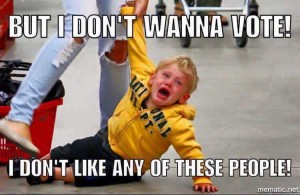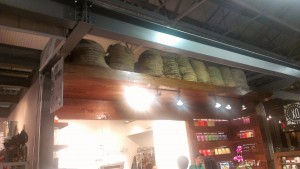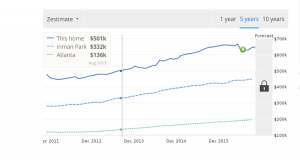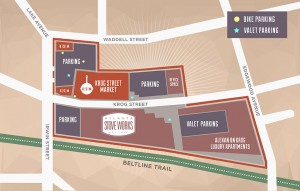Gentrification and Krog Street Market
Introduction
Gentrification is a process that is taking place not only in the United States but all over the world as well. Atlanta is no different. Atlanta has been heavily impacted by gentrification, and it continues to be affected by gentrification. Before getting into how gentrification is changing Atlanta, it is important to understand what gentrification is and what it does to an environment. According to PBS, gentrification is when wealthier people arrive in an existing urban district. However, this is not the only description of gentrification. There is much more to it than just the arrival of a wealthier group of people. Gentrification also impacts four aspects of a city: demographics, real estate markets, land use, and culture and character. Typically, with gentrification, when it comes to demographics, an increase in median income is observed as well as a decline in racial minorities. Gentrification causes extremely large increases in home prices as well as an increase in evictions and conversion of land into mixed-use (live, work, play) facilities. Gentrification can lead to a decline of industrial uses of land as well as an increase in office space and condos (essentially fewer houses, more apartments). Finally, gentrification can cause new ideas about what is desirable and new standards for architecture, public behavior, noise, and landscaping in an environment. While it is true that the homeowners benefit by the rising prices of their houses, the displacement of the minorities and small businesses that can no longer afford to be located in the gentrified area is too big of a consequence to pay. Another example of the negative impact of gentrification would be 49 Waddell Street (discussed below). The price of the home, overall, has increased by almost $200,000. However, taxes have gone down on the home almost by 10%. This will be discussed more in detail below, but this is just another example of how gentrification impacts an area.While some people praise gentrification for revitalizing an area, others complain that it has many problems that come with it. In reality, the costs of gentrification are simply too high.
Gentrification and Atlanta (Old Fourth Ward)
Atlanta is no stranger when it comes to gentrification. Gentrification has majorly impacted different areas of Atlanta and the results of it do not go unnoticed. “Live, work, play” developments are popping up all over the city. Where neighborhoods once stood now stand tall high-rise apartments. The price of housing is increasing by hundreds of thousands of dollars, pushing out poorer families and replacing them with wealthy singles or couples. This transformation has not come overnight, but rather has been a long process that has taken several years. This Built Environment Analysis will look intensely at the Old Fourth Ward area of Atlanta, specifically Krog Street Market and its impact on the surrounding neighborhood. According to the New York Times, Old Fourth Ward, once a heavily predominant black neighborhood, now has less than 75% black residents, which is down from the 94% that was recorded in 1990 (for reference, this article was published in 2006, so it is safe to assume the number of black residents has gone down even more due to gentrification). Also, housing prices have skyrocketed while low-rent apartments have been torn down and replaced by new developments. More and more white Atlanta citizens are moving into these once African American dominated areas, a key trend when it comes to the gentrification of the city. Because of gentrification in Atlanta, minority citizens of low-income areas are being forced out of their homes due to the high consequence that gentrification brings to it.
Krog Street Market History
Krog Street Market does not have a very long history, but the building it resides in does, dating back all the way to 1889. The building was first used by the Atlanta Stove Works company. The Atlanta Stove Works brought the “Barrett Range,” made of cast iron to Atlanta. This innovation of cooking made the company a lot of money, so much so that by 1935 they were already making about $500,000 a year. By 1969, the business had grown to over $35,000,000. However, in 1987 Atlanta Stove Works went out of business after being operational for almost 100 years. This left the buildings the company ran its operations out of empty. There was a giant piece of property going unused. This continued until around 2004 when some of the buildings were renovated to be mixed-use developments and restaurants (the beginning of the gentrification of the area). In 2006, Tyler Perry purchased the entire plot of land and converted all the buildings into Tyler Perry Studios, where multiple movies, stage plays and television programs were filmed and performed. The idea for Krog Street Market began in 2012. Tyler Perry sold the land to Paces Properties. By 2014, the renovation of the buildings had been completed, and Krog Street Market opened its doors to the public. However, because of the creation and opening of Krog Street Market, gentrification became a major part of not only Krog Street Market but also the neighborhood surrounding it.
Krog Street Market Gentrification
To better observe how Krog Street Market was being impacted by gentrification, I studied one house that is for sale on Waddell Street, the street that is directly next to Krog Street Market. This street is full entirely of houses so studying this one home could give me an idea of how, if at all, the gentrification due to Krog Street Market was having an effect. What I found was unbelievable. Zillow, a website where people can list their homes for sale, includes a helpful feature that shows how the price of the home has changed over time. When looking at 49 Waddell Street, there is a clear trend that is happening with the price of the home. It has increased steadily over time, a sign of gentrification. Looking at the house, in 2013, a year before Krog Street Market was opened, the house was valued at $501,000. This is a lot considering that the average price for a home in Atlanta at that time was $136,000. In August 2014, the month that Krog Street Market opened, the price of the house increased, most likely due to the opening of the market. The new value of the home was $561,000 (up $60,000) while the average price for a home in Atlanta increased to $158,000. Finally, this year in August of 2016, the value of the house next to Krog Street Market has jumped all the way to $630,000. The average price of a home in Atlanta, in comparison, has increased to $195,000. The increase of home value is what confirms gentrification in the area of Krog Street Market. Because the market was constructed, housing costs went up, thereby affecting who could reside in those homes. To make matters worse, the owner of 49 Waddell Street paid less in taxes in 2015 ($6,407) than he or she did in 2006 ($7,084). This is a decrease of $677, or almost 10%. Somehow the price of the home has increased nearly $200,000 but the amount of taxes paid by the owner has decreased by $677. How can a community survive and thrive when the taxpayers are not doing their part? Especially when school resources are dependent on the property tax values of the homeowners who live in the community! This is the dark side of gentrification.
Conclusion
Krog Street Market is a new, innovative retail space that features restaurants and shops right off the Beltline. It attracts thousands of visitors every year and creates a great environment for shopping, eating, and fun. However, the cost of Krog Street Market was more than simply the construction funds. Because of Krog Street Market’s building, the gentrification of the area surrounding it has increased. Gentrification affects all of Atlanta, but now the neighborhoods surround Krog Street Market are experiencing its effects. Krog Street Market has led to an increase in the price of homes surrounding the market. They have increased by hundreds of thousands of dollars since the market was constructed and opened its doors, the increase of cost being a clear indicator that gentrification is taking place. Because of the increase of prices, low-income families cannot live in these houses anymore. Only wealthy people, couples, or families can reside in these homes. While Krog Street Market has done a lot for the community by providing a place to relax, shop, and eat, its effects have been bad for its surrounding neighborhood. Because of Krog Street Market, gentrification has taken hold of the surrounding area, and its effects are being clearly seen and felt.
Sources:
http://www.zillow.com/homedetails/49-Waddell-St-NE-Atlanta-GA-30307/35860371_zpid/
http://www.pbs.org/pov/flagwars/what-is-gentrification/








